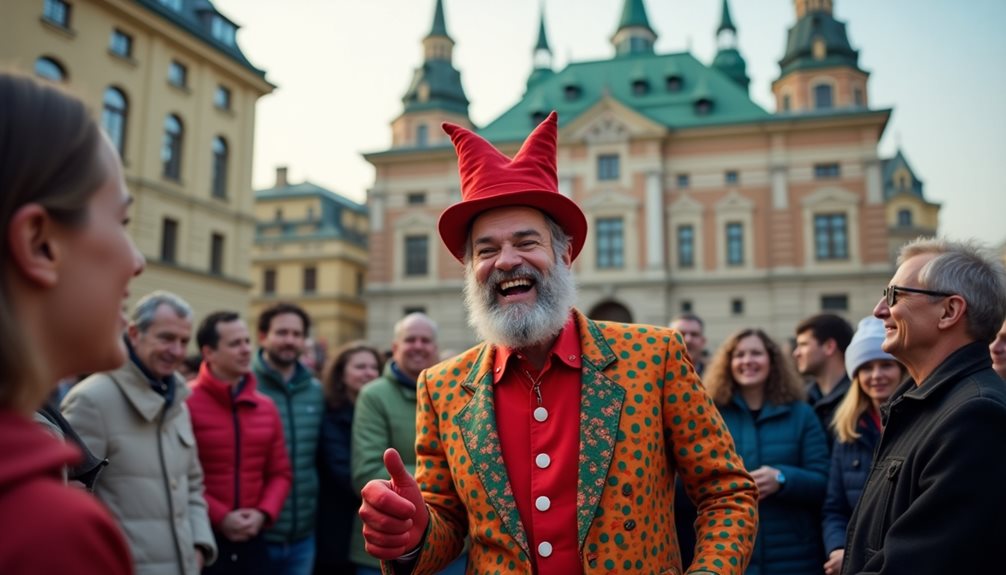Table of Contents
ToggleThe Origins of Russian Humor

Humor is a cherished thread in the fabric of every culture, and Russia’s brand of wit is especially unique, shaped by centuries of tradition, clever storytelling, and the joy of finding laughter even in life’s hardest moments.
Russian humor traces its roots to rich folk traditions—think of the mischievous peasant Ivan-durak (“Ivan the Fool”), who outsmarts greedy landowners with a simple smile and sharp mind. Folktales, proverbs, and jokes have always helped people find common ground and keep spirits high, no matter the circumstances.
In the 18th and 19th centuries, satire flourished in Russian literature. Writers like Nikolai Gogol and Mikhail Saltykov-Shchedrin used playful irony to highlight everyday absurdities. Their works, filled with colorful characters and sly observations, let people laugh at life’s contradictions while building a sense of unity.
What makes Russian humor stand out is its adaptability. From the witty wordplay of Soviet-era anecdotes (“anekdoty”) to today’s stand-up comedians and internet memes, laughter has always been a way for Russians to stay resilient, clever, and connected.
Humor in Russia is more than just a joke—it’s a way of seeing the world with optimism. Whether through a quick-witted retort or a lighthearted story shared over tea, Russians use humor to face challenges together.
There’s even a Russian holiday called “Day of Laughter” (День смеха), celebrated on April 1st—proof that humor is always welcome!
Key Elements of Russian Jokes
At the heart of Russian jokes lies a unique blend of cultural nuances and social commentary, which often reflects the complexity of the human experience. Central to this humor are wordplay techniques and irony usage, allowing for layers of meaning that resonate deeply within the audience. Russian jokes often subvert expectations, using clever puns or situational irony to highlight absurdities in everyday life.
Wordplay in Russian Jokes
Wordplay (игра слов, igra slov) is a common feature. Russian has many words that sound alike but have different meanings, which makes puns and double meanings especially popular. This clever use of language adds depth and surprise to jokes.
Irony in Russian Jokes
Irony (ирония, ironiya) is another central element. In Russian humor, irony is used to point out the difference between expectations and reality. This technique often highlights flaws in society or daily life by saying the opposite of what is meant.
Other Common Elements in Russian Jokes
- Satire (Сатира, satira):
Satirical jokes make fun of politics, society, or certain behaviors. They use humor to criticize or expose problems in a clever way. - Stereotypes (Стереотипы, stereotipy):
Some jokes rely on stereotypes about professions or nationalities. These jokes use common ideas or beliefs about different groups for comic effect. - Absurdity (Абсурд, absurd):
Absurd jokes highlight situations that are strange or illogical. This type of humor points out how things can be unexpectedly silly or nonsensical.
Useful Russian Terms for Jokes
| Russian (Cyrillic) | Phonetic (English) | English Definition |
|---|---|---|
| Анекдот | anekdot | joke (short funny story) |
| Игра слов | igra slov | wordplay/pun |
| Ирония | ironiya | irony |
| Сатира | satira | satire |
| Шутка | shutka | joke/quip |
| Абсурд | absurd | absurdity |
| Стереотип | stereotip | stereotype |
| Смешно | smeshno | funny |
| Рассмешить | rassmeshit’ | to make someone laugh |
| Подколоть | podkolot’ | to tease / poke fun |
These elements create a rich fabric that invites reflection and laughter alike.
Popular Themes in Russian Comedy
Russian comedy is known for its distinctive character, shaped by centuries of unique cultural experiences. When you dive into Russian humor, you discover a lively blend of wit, irony, and subtle observation that feels both familiar and novel to audiences from around the world.
One of the most prominent themes is satire. Russian comedians often use humor to gently poke fun at everyday routines and social conventions. This kind of satire doesn’t just entertain—it invites people to laugh at the quirks of their own society, finding common ground in shared habits, misunderstandings, and the small challenges of daily life.
Another hallmark of Russian comedy is its use of dark humor. Life in Russia has often been unpredictable, and this has given rise to jokes that find light in even the toughest situations. This style helps people cope with life’s ironies and twists; it’s a way to stay resilient by turning hardship into something everyone can laugh about together.
Wordplay is also a staple. Russian language itself lends to clever puns, double meanings, and playful twists. Comedians skillfully use these linguistic tools to create jokes that are both smart and memorable—some are so iconic that they become part of everyday conversation.
Physical comedy and slapstick have their place as well, often appearing in classic Soviet films and TV shows. These routines are rooted in universal human behavior and can be enjoyed by people of any age or background.
Finally, Russian comedy frequently draws on characters and stereotypes that represent different walks of life—city dwellers, villagers, intellectuals, workers—all with their own mannerisms and perspectives. Through these characters, comedians highlight both the differences and similarities that bring people together.
Through laughter, Russian comedy offers more than just entertainment; it provides insights into national character, everyday life, and the ways people connect with each other. For anyone interested in Russian culture or language, exploring these themes can be both enlightening and genuinely enjoyable.
The Role of Language in Humor
Language serves as a fundamental vehicle for humor, intricately shaping the way jokes are constructed and perceived within the Russian context. The unique characteristics of the Russian language lend themselves to a variety of comedic expressions, particularly through the use of wordplay techniques and idiomatic expressions.
Incorporating local vernacular to enhance relatability. Russian humor often relies on several linguistic techniques and the effectiveness of humor often hinges on:
- Puns and Double Meanings: Exploiting words that sound alike but have different meanings. For example, “мир” meaning both “peace” and “world,” which jokes might exploit with phrases like “Мы хотим мир во всём мире.”
- Cultural Idioms: Idioms play a major role; many jokes use set phrases that don’t translate directly, such as “вешать лапшу на уши” (to fool someone, literally “to hang noodles on someone’s ears”).
- Syntax Manipulation: Comedians also manipulate syntax, taking advantage of Russian’s flexible word order to create unexpected or absurd variations of familiar phrases (e.g., twisting the proverb “Без труда не вытащишь и рыбку из пруда”).
- Regional Dialects: Regional dialects and local slang are often included for authenticity and relatability, like using “шо” instead of “что” for “what” in southern speech.
| Russian Term | Phonetic (English) | English Definition |
|---|---|---|
| мир | meer | peace / world (double meaning) |
| вешать лапшу на уши | veshat’ lapshu na ushi | to fool someone (literally: to hang noodles on ears) |
| Без труда не вытащишь и рыбку из пруда | bez truda ne vytyashchish’ i rybku iz pruda | no pain, no gain (literally: you can’t pull a fish out of a pond without effort) |
| шо | sho | what (regional dialect, southern) |
| анекдот | anekdot | joke, anecdote |
| каламбур | kalambur | pun |
| шутка | shutka | joke |
| игра слов | igra slov | wordplay |
| идиома | idioma | idiom |
| поговорка | pogovorka | proverb |
| пословица | poslovitsa | saying, proverb |
| сарказм | sarkazm | sarcasm |
| ирония | ironiya | irony |
| юмор | yumor | humor |
| сленг | sleng | slang |
| диалект | dialekt | dialect |
These linguistic elements not only enrich the humor but also reflect the cultural nuances that shape comedic interactions, inviting audiences to engage in a deeper understanding of Russian humor.
Understanding Cultural References
Cultural references play a pivotal role in shaping humor within the Russian context, serving as a bridge between the audience’s shared experiences and the comedic narrative.
These references often draw from the rich fabric of Russian history, literature, and social dynamics, embedding idiomatic expressions that resonate deeply with local sensibilities. Understanding this cultural context is essential for fully appreciating the nuances of Russian comedy.
Jokes frequently rely on allusions to well-known figures or events, making them relatable yet challenging for outsiders. The interplay of language and culture enriches the humor, as idiomatic expressions can convey layered meanings that reflect societal attitudes.
Therefore, an awareness of these cultural references enhances one’s engagement with Russian humor, fostering a deeper connection to its comedic landscape.
![]()
Why Cultural References Matter
Russian jokes often mention famous people, events, or sayings from the country’s past and present. Without knowing these, a punchline might not make sense. Also, Russian humor uses a lot of wordplay, idioms, and sayings that don’t translate directly into English.
Example
- In English, someone might joke about “catching 22” (from the novel Catch-22), but in Russian, someone might say “Трое в лодке, не считая собаки” (Troye v lodke, ne schitaya sobaki), which is the Russian title of “Three Men in a Boat (To Say Nothing of the Dog)”—often used to refer to a group blundering their way through something.
Common Sources of Russian Cultural References
- Classic literature (Pushkin, Tolstoy, Dostoevsky)
- Soviet-era films and cartoons
- Political history (Tsars, Soviet Union, Perestroika)
- Folk tales and proverbs
- Popular music and TV
Idiomatic Expressions and Allusions
Idioms and references can have hidden meanings. Here’s a list of commonly used Russian cultural references with explanations:
| Russian (Cyrillic) | Phonetic (English) | English Definition |
|---|---|---|
| Мама мыла раму | mama myla ramu | “Mom washed the window frame” (common school phrase) |
| Дядя Стёпа | dyadya Styopa | Uncle Styopa (famous character: tall, kind policeman) |
| Чёрный квадрат | chyorny kvadrat | Black Square (famous painting by Malevich) |
| Заставить работать как лошадь | zastavit rabotat kak loshad | To make someone work like a horse (work very hard) |
| Ни пуха ни пера | ni pukha ni pera | “Neither fluff nor feather” (means ‘good luck’) |
| Бабушка надвое сказала | babushka nadvoye skazala | “Grandma said it two ways” (the outcome is uncertain) |
| Как у Христа за пазухой | kak u Khrista za pazukhoy | “Like at Christ’s bosom” (very safe and comfortable) |
| Гоголевский Петербург | Gogolevskiy Peterburg | “Gogol’s St. Petersburg” (refers to gloomy settings) |
| Перестройка | perestroyka | “Restructuring” (refers to period of Soviet reforms) |
| Хрущёвка | khrushchyovka | Type of Soviet-era apartment building |
How This Helps You
Learning these references helps you:
- Understand Russian jokes and memes
- Recognize why certain phrases are funny or ironic
- Participate more fully in conversations
- Appreciate TV shows, movies, and books
By paying attention to these cultural touchstones, your understanding of Russian language and humor becomes much richer.
How to Appreciate Russian Comedy as a Learner

Appreciating Russian comedy requires more than just an understanding of the language; it demands an exploration of the intricate social and historical contexts that shape its humor.
Here’s how to deepen your understanding and enjoyment:
1. Cultural Nuances
Russian comedy frequently pokes fun at everyday life, social structures, and common stereotypes within Russian society. For example, jokes about bureaucracy, communal apartments, or “the Russian soul” (русская душа – russkaya dusha) are prevalent.
- Example: A popular comedic trope is the “blat” system (блат – blat: connections/influence), where knowing the right people is more important than following official procedures.
2. Comedic Timing
Pay attention to pauses, intonation, and facial expressions. Russian comedians often use deadpan delivery or exaggerated reactions for effect. Timing can change a simple phrase into a punchline.
- Example: In stand-up or sketch shows like “КВН” (KVN), humor often relies on quick exchanges and witty comebacks.
3. Historical Context
Many jokes reference historical events, literature, and famous figures. Understanding these references provides added layers of appreciation.
- Example: Jokes referencing classic Russian literature, such as “Обломов” (Oblomov) by Ivan Goncharov, are common. The main character, Oblomov, is famous for his laziness and indecision.
- Context: Calling someone “Обломов” humorously suggests they are extremely lazy or indecisive.
For example: “Сидишь тут как Обломов!” (Sidish’ tut kak Oblomov!) — “You’re sitting here like Oblomov!”
- Context: Calling someone “Обломов” humorously suggests they are extremely lazy or indecisive.
4. Language Play
Russian comedians love puns, double meanings, and playful twists on words. These are challenging to translate but rewarding when understood.
- Example: The phrase “кот наплакал” (kot naplakal) literally means “the cat cried [so little],” but it’s a humorous way to say “very little” or “hardly any.”
- Context: If someone says, “У меня денег — кот наплакал,” (U menya deneg — kot naplakal), it means, “I have hardly any money.”
The funny image of a cat crying just a few tears adds a playful twist to the expression.
- Context: If someone says, “У меня денег — кот наплакал,” (U menya deneg — kot naplakal), it means, “I have hardly any money.”
By focusing on these aspects and familiarizing yourself with key terms, you can better appreciate the richness and wit of Russian comedy.
Frequently Asked Questions
What Are Some Famous Russian Comedians to Know?
Famous Russian comedians, such as Mikhail Zhvanetsky and Dmitry Nagiyev, showcase diverse comedic styles, ranging from satirical observations to character-driven performances. Their popular acts reflect societal nuances, making them significant figures in contemporary Russian entertainment.
How Has Russian Humor Evolved Over Time?
Russian humor has evolved considerably, reflecting cultural influences and historical contexts. From Soviet-era satire to contemporary stand-up, it mirrors societal changes, showcasing resilience and adaptability, while often challenging norms and encouraging freedom of expression through wit.
Are There Specific Regions Known for Unique Russian Jokes?
Specific regions in Russia exhibit distinct regional humor, reflecting cultural differences. For instance, Siberian jokes often emphasize resilience, while urban centers showcase witty social commentary, illustrating how geography influences comedic expression and societal perspectives across the nation.
Can Russian Humor Be Translated Accurately Into Other Languages?
Translating Russian humor into other languages presents significant linguistic challenges, as cultural nuances often shape comedic expression. Without careful consideration of these subtleties, much of the humor’s essence and impact may be lost in translation.
How Do Social Media Influence Russian Comedy Today?
Social media greatly influences contemporary Russian comedy by shaping comedy trends, allowing for rapid dissemination of humor and fostering community engagement. This digital platform enables comedians to reach wider audiences, adapting content to societal shifts and preferences.



